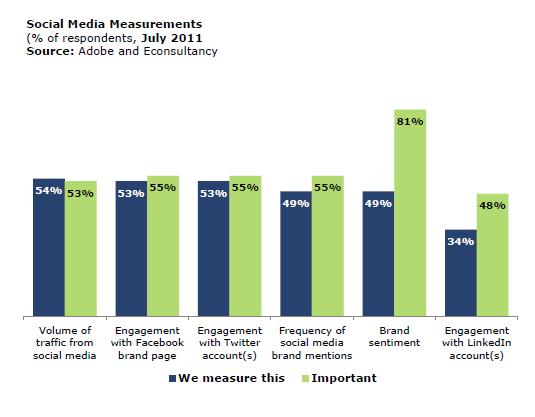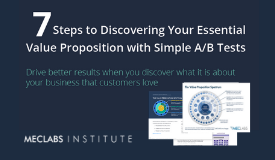Social Media Marketing: Analytics are free and plentiful, so use them
For years, the debate on social media marketing centered on ROI. Marketers asked themselves “How can we measure the impact of social media?” “What’s the ROI on Twitter?” “How do we know if LinkedIn is worthwhile?”
Thankfully, those days are behind us. Data is available from tools both paid and free. Unfortunately, for whatever reason, not every marketer has taken advantage, as you can see in the chart below from Adobe and Econsultancy, which we pulled from The Social Media Data Stacks e-book.
–
–
Five of the six metrics listed above have a greater number of marketers saying they’re important than the number of marketers tracking them. This is like saying it’s important to eat right and exercise while eating chili cheese fries and canceling your gym membership. It just doesn’t make sense.
But don’t worry — we have you covered. Here is a list of free tools you can use to start measuring each social media metric.
–
1. Brand Sentiment
Let’s get right to the heart of the matter. According to the chart, more than 80% of marketers say measuring brand sentiment is important, yet fewer than half actually track it. You can start gauging sentiment today by spending two minutes playing with Social Mention.
This fantastically simple and free tool provides a stunning amount of data, including a sentiment analysis of your online mentions. You can even click “positive” and “negative” to see a list of results used to generate your score. How cool is that?
–
2. Volume of Social Media Traffic
This one should be easy. Segmenting your incoming traffic by source will reveal which visitors come from social networks, blogs and forums. You can measure traffic in aggregate or segment it by referring site. Google Analytics is the most popular site analytics tool and is completely free.
–
3. Engagement with Facebook Brand Page
Facebook provides deliciously detailed metrics on interactions with your profile though its Insights platform. The free service details traffic, ‘likes,’ comments, sharing activity and other data. It will even segment the data by age, sex and region. What more could you want?
–
4. Engagement with Twitter Account(s)
This one is a little more abstract. People don’t normally go to your Twitter profile to read your updates, right? They see them in feeds or a tool. They really engage with your content (the tweets) by clicking your links, replying, re-Tweeting, etc.
You can monitor clicks and mentions of your links with bitly, the free URL shortening service. Just add “+” to the end of any bit.ly URL to see a dashboard (e.g. https://bitly.com/szahlt+). Also, the site Twitrratr provides free sentiment analysis, and Hashtags.org will chart the mentions of your campaign #hashtags over time. Sah-weet.
–
5. Frequency of Social Media Brand Mentions
We already mentioned Social Mention, but let’s reiterate. Not only will it count the mentions of your brand, but it will rank the keywords, hashtags, sources, and top users around them, too.
–
6. Engagement with LinkedIn Account(s)
LinkedIn reports the unique views and visits to your company profile and will segment the traffic by industry, job title and company. You can get similar stats on the audience in your LinkedIn group, as well as metrics on your audience growth and activity. Just click the Group Statistics banner ad in the lower right of any group page and you’ll see metrics such as those on the MarketingExperiments Optimization group dashboard. And yes, it’s all free.
–
NOTE: Measure real goals
At face value, these metrics do not mean anything. The CEO is not going to care that sentiment on Twitter is up, or that you netted 40,000 Facebook followers this year. You have to associate these metrics with money by connecting them to conversion or transactional data.
For example, you may use social metrics to help increase your audience and engagement on LinkedIn or Facebook — but how did the growth help your company? Is referral traffic from LinkedIn to your site way up? Do visitors from Facebook have higher conversion rates? Do they share your content and offers and increase your reach? All this data is available if you are willing to connect the dots.
–
Related Resources:
The Social Media Data Stacks e-book by MarketingCharts and HubSpot
Social Media Marketing: How does Google+ fit into the social media puzzle?
Social Media Marketing: 9 tactics for B2B social channel advertising
Social Media Marketing: 8 tactics to measure and improve Facebook results
Social Media Marketing: 4 tactics for finding and winning hyper-social consumers
Social Media Measurement: Are you getting value out of Twitter and its peers?
Categories: Social Networking Evangelism Community analytics, brand, Facebook, LinkedIn, metrics, ROI, social marketing, social media, Twitter











Google Analytics’ new multi-channel conversion assist attribution data reporting feature is also a great boon for measuring social ROI. So in addition to getting data on traffic delivered from social outposts to your website, you can now also segment the impact of that traffic in acheiving your goal conversions (whatever they may be).
Good article for those just starting out and perhaps working with smallish budgets. However sentiment coding is notoriously inaccurate due to the unstructured nature of social conversation. “I’m having a terrible day, sitting in Starbucks sipping my latte,” would show as negative sentiment when really it could be positive or at least neutral. After all, the latte could be a welcome salve for the trials of that day for the poster.
What is important is what you do with the information and how you link it to other research in order to propel your company forward. While the tools mentioned are useful, you may need additional ones as your social media deployment grows and you start to align your social research analytics with those more traditional research sources.
Good report. I’ve some big companies are hesitant to get involved with social media marketing because they didn’t know how to measure it. Sounds like an excuse to me. It sounds like they don’t understand it or know how to put a strategy together in considering HR policy. Kudos to those companies that have jumped in and are rocking, Starbucks, Best Buy.
There’s a wealth of knowledge about your social media efforts waiting to be unlocked at Google Analytics. I just presented on how to measure the value of social media at the recent Site Executive user conference in Baltimore and showed how you can create a custom advanced segment to analyze traffic from social sites and then measure how that traffic converts to your goals when benchmarked against other types of traffic. And of course you shouldn’t forget how to measure earned media: http://www.dansoschin.com/2011/08/18/the-value-of-a-like-on-facebook/
Great report – no doubt there are more helpful social media metrics out there than just a few years ago, making it easier to evaluate the success of your social efforts. For me, it’s still all a surrogate for ROI, not an easier way to calculate ROI (but in many industries the ROI calculation challenge for marketing spend has been a long standing issue, and social is no different from traditional or other digital in that regard). Platform limitations, etc. still make it more difficult to understand social versus your own web properties, but the volume of information derived from social is amazing.
I’m starting to look at aggregated digital metrics – if I see a decline in consumer visitation to my web site, but I see a concurrent increase in my FB traffic, is that good or bad? When I look at the net of all digital, the answer might be more clear. Today, more than ever, our consumers can choose one or more of their preferred channels and my job is to be present in the medium they prefer.
Social Mention is fantastic! Highly Recommended! 🙂
Dilanka
Great advice! I’m just starting out (just completed the clickminded seo training course) and can’t wait to get started with the data end of it. I’ll definitely reference your article as I go along.
Great list of helpful tools. Thanks for sharing. I personally cannot live without Google Analytics for our Mention.com blog
Patricia